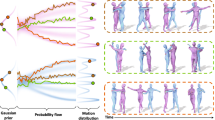Abstract
This paper presents a framework for generating animation sequences while maintaining desirable physical properties in a deformable shape. The framework consists of three important processes. Firstly, considering the given key pose configurations in the form of unarticulated meshes in high dimensional space, we cast our motion in low dimensional space using the unsupervised learning method of locally linear embedding (LLE). Corresponding to each point in LLE space, we can reconstruct the in-between pose using generalized radial basis functions. Next we create a map in the LLE space of the values for the different physical properties of the mesh, for example area, volume, etc. Finally, a probability distribution function in LLE space helps us rapidly choose the required number of in-between poses with desired physical properties. A significant advantage of this framework is that it relieves the animator the tedium of having to carefully provide key poses to suit the interpolant.
Similar content being viewed by others
References
Arikan, O., Forsyth, D.A.: Interactive motion generation from examples. In: SIGGRAPH ’02: Proceedings of the 29th Annual Conference on Computer Graphics and Interactive Techniques, pp. 483–490. New York, NY, USA (2002)
Arikan, O., Forsyth, D.A., O’Brien, J.F.: Motion synthesis from annotations. ACM Trans. Graph. 22(3), 402–408 (2003)
Bishop, C.M., Svensen, M., Williams, C.K.I.: GTM: The generative topographic mapping. Neural Comput. 10(1), 215–234 (1998)
Bregler, C., Omohundro, S.: Nonlinear image interpolation using manifold learning. In: Advances in Neural Information Processing Systems, vol. 7, pp. 973–980 (1995)
Bruderlin, A., Williams, L.: Motion signal processing. In: SIGGRAPH ’95: Proceedings of the 22nd Annual Conference on Computer Graphics and Interactive Techniques, pp. 97–104. New York, NY, USA (1995)
DeMers, D., Cottrell, G.: Non-linear dimensionality reduction. In: Advances in Neural Information Processing Systems, pp. 580–587 (1993)
Der, K.G., Sumner, R.W., Popović, J.: Inverse kinematics for reduced deformable models. ACM Trans. Graph. 25(3), 1174–1179 (2006)
Elgammal, A.M.: Learning to track: Conceptual manifold map for closed-form tracking. In: 2005 IEEE Computer Society Conference on Computer Vision and Pattern Recognition (CVPR 2005), pp. 724–730. San Diego, CA, USA, (2005)
Elgammal, A.M., Lee, C.S.: Inferring 3D body pose from silhouettes using activity manifold learning. In: In Proceedings of IEEE Conference on Computer Vision and Pattern Recognition (CVPR), vol. 2, pp. 681–688. Washington DC, USA (2004)
James, D.L., Pai, D.K.: DyRT: dynamic response textures for real time deformation simulation with graphics hardware. ACM Trans. Graph. 21(3), 582–585 (2002)
Kochanek, D.H.U., Bartels, R.H.: Interpolating splines with local tension, continuity, and bias control. In: SIGGRAPH ’84: Proceedings of the 11th Annual Conference on Computer Graphics and Interactive Techniques, pp. 33–41. New York, NY, USA (1984)
Kohonen, T.: Self-Organizing Maps, 2nd edn. Springer, Heidelberg (1997)
Kovar, L., Gleicher, M.: Flexible automatic motion blending with registration curves. In: SCA ’03: Proceedings of the 2003 ACM SIGGRAPH/Eurographics Symposium on Computer Animation, pp. 214–224. Aire-la-Ville, Switzerland (2003)
Kovar, L., Gleicher, M., Pighin, F.: Motion graphs. In: SIGGRAPH ’02: Proceedings of the 29th Annual Conference on Computer Graphics and Interactive Techniques, pp. 473–482. New York, NY, USA (2002)
Lee, C., Elgammal, A.M.: Facial expression analysis using nonlinear decomposable generative models. In: IEEE International Workshop on Analysis and Modeling of Faces and Gestures (AMFG), pp. 17–31 (2005)
Lewis, J.P., Cordner, M., Fong, N.: Pose space deformation: a unified approach to shape interpolation and skeleton-driven deformation. In: SIGGRAPH ’00: Proceedings of the 27th Annual Conference on Computer Graphics and Interactive Techniques, pp. 165–172. New York, NY, USA (2000)
Li, Y., Wang, T., Shum, H.Y.: Motion texture: a two-level statistical model for character motion synthesis. In: SIGGRAPH ’02: Proceedings of the 29th Annual Conference on Computer Graphics and Interactive Techniques, pp. 465–472. New York, NY, USA (2002)
Lipman, Y., Cohen-Or, D., Ran, G., Levin, D.: Volume and shape preservation via moving frame manipulation. ACM Trans. Graph. 26(1), 5 (2007)
Pentland, A., Williams, J.: Perception of non-rigid motion: Inference of shape, material and force. In: Proceedings of the 11th International Joint Conferences on Artificial Intelligence, pp. 1565–1570. Detroit, MI, USA (1989)
Poggio, T., Girosi, F.: Network for approximation and learning. Proc. of IEEE 78(9), 1481–1497 (1990)
Rose, C., Cohen, M.F., Bodenheimer, B.: Verbs and adverbs: Multidimensional motion interpolation. IEEE Comput. Graph. Appl. 18(5), 32–40 (1998)
Saul, L.K., Roweis, S.T.: Nonlinear dimensionality reduction by locally linear embedding. Science 290, 2323–2326 (2000)
Saul, L.K., Roweis, S.T.: Think globally, fit locally: unsupervised learning of low dimensional manifolds. J. Mach. Learn. Res. 4, 119–155 (2003)
Sloan, P.J., Rose, C.F., III, Cohen, M.F.: Shape by example. In: SI3D ’01: Proceedings of the 2001 Symposium on Interactive 3D Graphics, pp. 135–143. New York, NY, USA (2001)
Sumner, R.W., Popović, J.: Deformation transfer for triangle meshes. ACM Trans. Graph. 23(3), 399–405 (2004)
Sumner, R.W., Zwicker, M., Gotsman, C., Popović, J.: Mesh-based inverse kinematics. ACM Trans. Graph. 24(3), 488–495 (2005)
Thalmann, N.M.: Computer Animation: Theory and Practice. Springer, New York, NY, USA (1985)
Witkin, A., Baraff, D.: Physically-based modelling. In: ACM SIGGRAPH 2001, Course Notes (2001)
Witkin, A., Popović, Z.J.: Motion warping. In: SIGGRAPH ’95: Proceedings of the 22nd Annual Conference on Computer Graphics and Interactive Techniques, pp. 105–108. New York, NY, USA (1995)
Zhang, L., Snavely, N., Curless, B., Seitz, S.M.: Spacetime faces: high resolution capture for modeling and animation. In: SIGGRAPH ’04: ACM SIGGRAPH 2004 Papers, pp. 548–558. New York, NY, USA (2004)
Author information
Authors and Affiliations
Corresponding author
Rights and permissions
About this article
Cite this article
Jin, C., Fevens, T., Li, S. et al. Motion learning-based framework for unarticulated shape animation . Visual Comput 23, 753–761 (2007). https://doi.org/10.1007/s00371-007-0141-8
Published:
Issue Date:
DOI: https://doi.org/10.1007/s00371-007-0141-8




